 | | | Switch to: Europe, USA, New Zealand, Antarctica Credit: NOAA/Ovation  Planetary K-index Planetary K-index
Now: Kp= 2.00 quiet
24-hr max: Kp= 3.00 quiet
explanation | more data
Interplanetary Mag. Field
Btotal: 8.27 nT
Bz: -1.38 nT south
more data: ACE, DSCOVR
Updated: Today at 1146 UT  Coronal Holes: 10 Jan 23 Coronal Holes: 10 Jan 23 
There are no significant coronal holes on the Earthside of the sun. Credit: SDO/AIA  Noctilucent Clouds Noctilucent Clouds
The southern hemisphere season for noctilucent clouds has begun. NASA's AIM spacecraft detected the first electric-blue puffs over Antarctica on Dec. 1st. Switch view:Ross Ice Shelf, Antarctic Peninsula, East Antarctica, Polar Updated Jan10  SPACE WEATHER
NOAA Forecasts | | Updated at: 2023 Jan 10 2200 UTC FLARE | 0-24 hr | 24-48 hr | CLASS M | 70 % | 70 % | CLASS X | 30 % | 30 % |  Geomagnetic Storms: Geomagnetic Storms:
Probabilities for significant disturbances in Earth's magnetic field are given for three activity levels: active, minor storm, severe storm Updated at: 2023 Jan 10 2200 UTC Mid-latitudes | 0-24 hr | 24-48 hr | ACTIVE | 30 % | 15 % | MINOR | 10 % | 01 % | SEVERE | 01 % | 01 % | High latitudes | 0-24 hr | 24-48 hr | ACTIVE | 15 % | 15 % | MINOR | 30 % | 20 % | SEVERE | 40 % | 20 % | | | |  | | | | | | | | | | | Never miss another geomagnetic storm. Sign up for Space Weather Alerts and you'll receive a text message when magnetic storms erupt. Aurora tour guides and professional astronomers use this service. You can, too! | | | NO CME THIS TIME: Yesterday's X1.9-class solar flare did not hurl a CME toward Earth. Although it was intense, the blast was too brief to lift a CME out of the sun's atmosphere. Next time may be different. There are now three large sunspots (AR3181, 82 and 84) with unstable 'delta-class' magnetic fields capable of strong explosions. NOAA forecasters say there is a 35% chance of X-flares on Jan. 10th. X-flare alerts: SMS Text. X-CLASS SOLAR FLARE: Yesterday in Kentucky, amateur astronomer Richard Schrantz was scanning the sun with his solar telescope when, almost finished, he decided to take one last look at sunspot AR3184. "What luck!" he says. "There was a big X1.9 solar flare in progress." 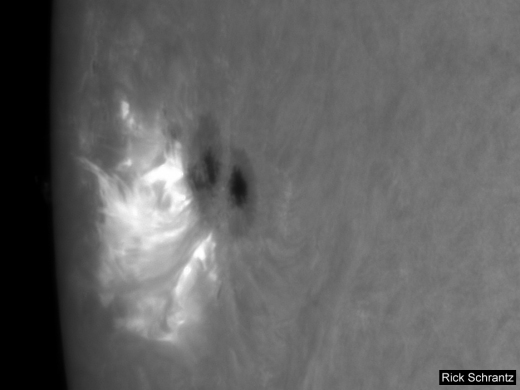
"The flare is listed as happening at 18:50 UT, and my image is just a few minutes later at 18:55 UT," says Schrantz. "To capture the eruption I used a 127mm refracting telescope with a Daystar Quark Chromosphere filter." Right now, the sun is so active it is possible to catch X-flares by accident. Success rates may be further improved by instant text alerts when flares are in progress. more images: from Laurie Sibbald of Cypress County, Alberta; from Sylvain Weiller of Jerusalem, Israel Realtime Space Weather Photo Gallery
Free: Spaceweather.com Newsletter SOLAR FLARE CAUSES RARE 'MAGNETIC CROCHET': The X-flare of Jan. 9th did something rare. It jerked Earth's magnetic field. Here is a composite of magnetometer recordings from Boulder, Colorado; Honolulu, Hawaii; and Fredericksburg, Virginia: 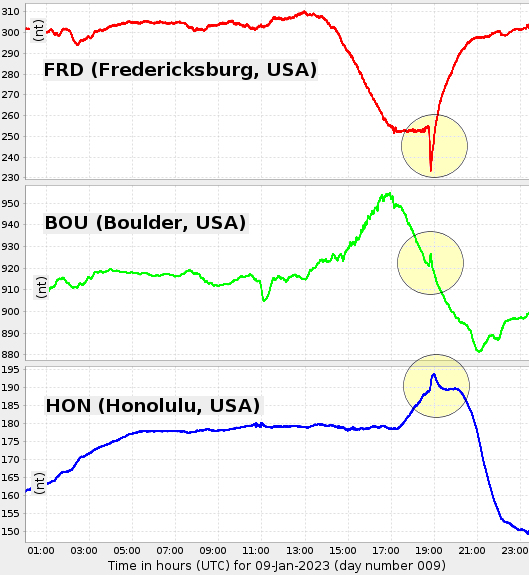 Full recordings: FRD, BOU, HON. Credit: International Real-time Magnetic Observatory Network (INTERMAGNET) Full recordings: FRD, BOU, HON. Credit: International Real-time Magnetic Observatory Network (INTERMAGNET)
The "jerk" is circled in yellow. It began around 1846 UT, and was detected by many magnetic observatories across the dayside of Earth. The phenomenon is called a 'magnetic crochet.' Radiation from the flare ionized the top of Earth's atmosphere and caused currents to flow 60 km to 100 km above Earth's surface. These currents, in turn, briefly altered Earth's magnetic field. Everything returned to normal a few minutes later. Realtime Space Weather Photo Gallery
Free: Spaceweather.com Newsletter VALENTINE'S CRYSTAL BEAR AND ROSE: Valentine's Day is coming. Looking for a far-out gift? This Crystal Bear and Rose flew to the stratosphere onboard a cosmic ray research balloon on Dec. 17th:
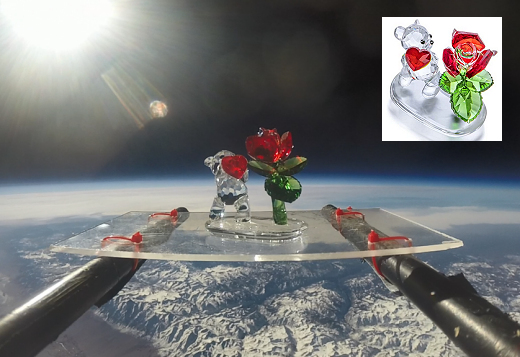
You can have it for $129.95. The students of Earth to Sky Calculus are selling space bears to support their high-altitude ballooning program. Each one comes with a greeting card showing the ursine astronaut in flight and telling the story of its journey to the edge of space and back again. Far Out Gifts: Earth to Sky Store
All sales support hands-on STEM education
Realtime Aurora Photo Gallery
Free: Spaceweather.com Newsletter Every night, a network of NASA all-sky cameras scans the skies above the United States for meteoritic fireballs. Automated software maintained by NASA's Meteoroid Environment Office calculates their orbits, velocity, penetration depth in Earth's atmosphere and many other characteristics. Daily results are presented here on Spaceweather.com. On Jan 10, 2023, the network reported 13 fireballs.
(11 sporadics, 1 Quadrantid, 1 theta Coronae Borealid) 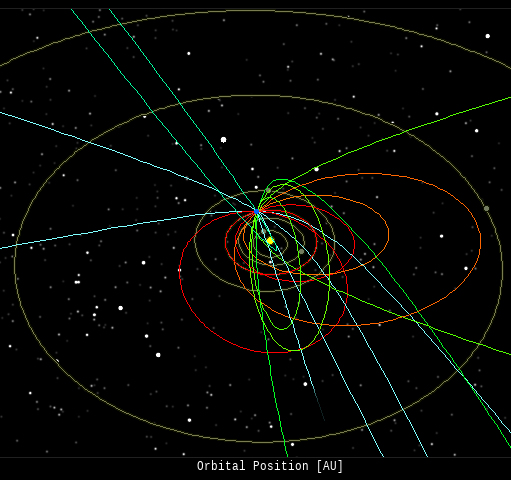 In this diagram of the inner solar system, all of the fireball orbits intersect at a single point--Earth. The orbits are color-coded by velocity, from slow (red) to fast (blue). [Larger image] [movies] Potentially Hazardous Asteroids ( PHAs) are space rocks larger than approximately 100m that can come closer to Earth than 0.05 AU. None of the known PHAs is on a collision course with our planet, although astronomers are finding new ones all the time. On January 10, 2023 there were 2324 potentially hazardous asteroids.
 | Recent & Upcoming Earth-asteroid encounters: | Asteroid | Date(UT) | Miss Distance | Velocity (km/s) | Diameter (m) | | 2022 YL4 | 2023-Jan-05 | 5.2 LD | 2 | 11 | | 2022 YN1 | 2023-Jan-06 | 18.3 LD | 5.5 | 52 | | 2021 TL | 2023-Jan-09 | 14.2 LD | 8.5 | 75 | | 2022 YD5 | 2023-Jan-12 | 8.3 LD | 10.6 | 48 | | 2022 YZ2 | 2023-Jan-12 | 16.6 LD | 6.5 | 79 | | 2022 YS5 | 2023-Jan-13 | 15.6 LD | 6 | 42 | | 2014 LJ | 2023-Jan-14 | 4.8 LD | 3.5 | 7 | | 2022 YH3 | 2023-Jan-14 | 19 LD | 16.3 | 93 | | 2012 BV13 | 2023-Jan-16 | 12.2 LD | 6.7 | 134 | | 2020 BP | 2023-Jan-20 | 5.2 LD | 16.9 | 26 | | 2019 BO2 | 2023-Jan-24 | 12.1 LD | 16.2 | 21 | | 2019 BZ4 | 2023-Jan-24 | 16.5 LD | 5.6 | 20 | | 2020 BZ14 | 2023-Jan-26 | 8.8 LD | 6.7 | 54 | | 2022 SO113 | 2023-Jan-29 | 10.5 LD | 3.5 | 73 | | 2017 DU34 | 2023-Feb-02 | 13.3 LD | 11.2 | 16 | | 367789 | 2023-Feb-03 | 4.7 LD | 9.9 | 149 | | 2020 OO1 | 2023-Feb-04 | 4.8 LD | 7.7 | 19 | | 2022 YO6 | 2023-Feb-06 | 12.1 LD | 13.4 | 186 | | 2022 CX1 | 2023-Feb-09 | 17.4 LD | 13.2 | 14 | | 2021 EP4 | 2023-Feb-13 | 19 LD | 6.1 | 5 | | 199145 | 2023-Feb-16 | 12 LD | 24.6 | 756 | | 2022 RG | 2023-Feb-16 | 8.2 LD | 3 | 24 | | 2020 DG4 | 2023-Feb-17 | 1.4 LD | 6.9 | 8 | | 2020 CX1 | 2023-Feb-19 | 17.4 LD | 7.7 | 53 | | 37638 | 2023-Feb-21 | 17 LD | 11.1 | 495 | | 2012 DK31 | 2023-Feb-27 | 12.6 LD | 15.5 | 148 | | 2006 BE55 | 2023-Feb-28 | 9.4 LD | 13.3 | 148 | | 2021 QW | 2023-Mar-03 | 13.9 LD | 12.1 | 79 | | 2017 BM123 | 2023-Mar-03 | 12.1 LD | 7.8 | 62 | | 2007 ED125 | 2023-Mar-03 | 11.7 LD | 13.1 | 224 | | 2015 EG | 2023-Mar-04 | 13.9 LD | 10.6 | 27 | | 535844 | 2023-Mar-07 | 10.5 LD | 7.7 | 150 | | 2020 FQ | 2023-Mar-09 | 14 LD | 6.3 | 13 | Notes: LD means "Lunar Distance." 1 LD = 384,401 km, the distance between Earth and the Moon. 1 LD also equals 0.00256 AU. | | Cosmic Rays in the Atmosphere | SPACE WEATHER BALLOON DATA: Almost once a week, Spaceweather.com and the students of Earth to Sky Calculus fly space weather balloons to the stratosphere over California. These balloons are equipped with sensors that detect secondary cosmic rays, a form of radiation from space that can penetrate all the way down to Earth's surface. Our monitoring program has been underway without interruption for 7 years, resulting in a unique dataset of in situ atmospheric measurements. Latest results (July 2022): Atmospheric radiation is decreasing in 2022. Our latest measurements in July 2022 registered a 6-year low: 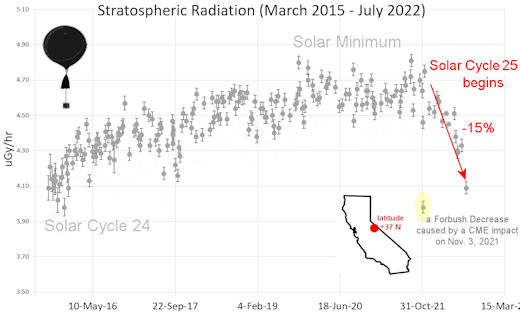
What's going on? Ironically, the radiation drop is caused by increasing solar activity. Solar Cycle 25 has roared to life faster than forecasters expected. The sun's strengthening and increasingly tangled magnetic field repels cosmic rays from deep space. In addition, solar coronal mass ejections (CMEs) sweep aside cosmic rays, causing sharp reductions called "Forbush Decreases." The two effects blend together to bring daily radiation levels down. .Who cares? Cosmic rays are a surprisingly "down to Earth" form of space weather. They can alter the chemistry of the atmosphere, trigger lightning, and penetrate commercial airplanes. According to a study from the Harvard T.H. Chan school of public health, crews of aircraft have higher rates of cancer than the general population. The researchers listed cosmic rays, irregular sleep habits, and chemical contaminants as leading risk factors. A number of controversial studies (#1, #2, #3, #4) go even further, linking cosmic rays with cardiac arrhythmias and sudden cardiac death. Technical notes: The radiation sensors onboard our helium balloons detect X-rays and gamma-rays in the energy range 10 keV to 20 MeV. These energies span the range of medical X-ray machines and airport security scanners. Data points in the graph labeled "Stratospheric Radiation" correspond to the peak of the Regener-Pfotzer maximum, which lies about 67,000 feet above central California. When cosmic rays crash into Earth's atmosphere, they produce a spray of secondary particles that is most intense at the entrance to the stratosphere. Physicists Eric Regener and Georg Pfotzer discovered the maximum using balloons in the 1930s and it is what we are measuring today. | | The official U.S. government space weather bureau | | | The first place to look for information about sundogs, pillars, rainbows and related phenomena. | | | Researchers call it a "Hubble for the sun." SDO is the most advanced solar observatory ever. | | | 3D views of the sun from NASA's Solar and Terrestrial Relations Observatory | | | Realtime and archival images of the Sun from SOHO. | | | information about sunspots based on the latest NOAA/USAF Active Region Summary | | | current counts of failed and deployed Starlink satellites from Jonathan's Space Page | | | Authoritative predictions of space junk and satellite re-entries | | | from the NOAA Space Environment Center | | | fun to read, but should be taken with a grain of salt! Forecasts looking ahead more than a few days are often wrong. | | | from the NOAA Space Environment Center | | | the underlying science of space weather |  | BestCSGOGambling is the best site for everything related to CSGO gambling on the web |  | To find reviews of new online casino sites in the UK try The Casino DB where there are hundreds of online casino reviews complete with bonuses and ratings. Alternatively, Online-Casinos.xyz is another massive directory of online casinos listing sites for the UK and Worldwide. Casinos that offer Rupees for bonuses are very generous to Indian players. Find the best online casinos in India at AllCasinos.in Looking for a new online casino? Try Casimpo the new site dedicated to making online casino simple, or check out the new Avenger Slots Casino and Ace Online Casino with over 500 online slots and casino games. |  | When looking for casinos to play online when the weather is bad, you can try casino online trucchi for Italian games. If you are not from Finland you can try the Swedish page Svenska casino online to find suitable games, check out svenskacasinoonline.net. Always check your local laws before playing with real money. |  | Looking for sports betting companies not registered on GamStop? CasinoGap has presented a list of sites not on GamStop available for UK players. Check and bet online! Would you like to bet at sites not using GamStop? Look at a list of NonStopCasino sites for online betting that aren't on GamStop. Top-rated bookmakers ever! | | | These links help Spaceweather.com stay online. Thank you to our supporters! | | | | | | | | |  | |  |   | ©2021 Spaceweather.com. All rights reserved. This site is penned daily by Dr. Tony Phillips. | |

